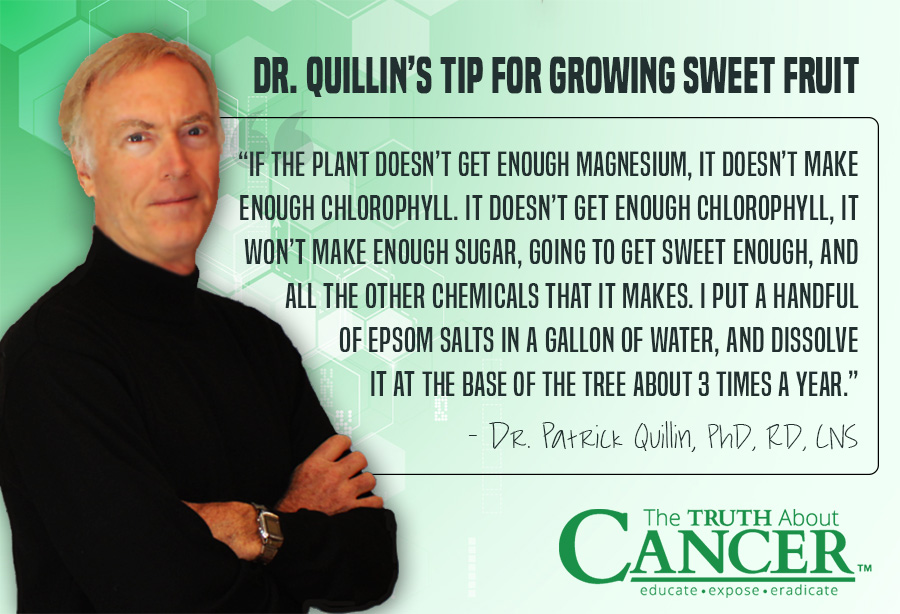Video Transcript: Organic Gardening with Dr. Patrick Quillin
Dr. Quillin: You can see these figs, and we’ll see if we can find something that’s ripe, because it’s the early part of the harvest. There we go. Ty, you get to taste that. So, longue verde means green, but inside, they’re purple. If you’d show the camera what we have inside there. And so, fisetin is one of the more important phytochemicals in figs, and again, proven to stimulate apoptosis, or programmed cell death in cancer cells. Delicious.
And if you think of all the ingredients, one of the things you’re looking for here is prebiotics. Plant food, fruits, vegetables, grains, legumes, contain substances that we cannot digest, but our hundred trillion cells in the gut are using it for food. And if we feed our gut properly, it’s called the microbiota, what we end up is we’re making vitamin biotin, vitamin K. We’re also stimulating the immune system. What they find now is two thirds of the immune system surrounds the gut, and by things we cannot digest — that prebiotics — are going to improve our immune system.
This is dark, this is Black Mission figs.
Ty Bollinger: Incredible.
Dr. Quillin: This one’s not quite ripe, but you can see we’re going to have a great harvest here. And you know, people will think, “Yeah you’re some rich doctor in California. I can’t afford that.” Sixty-two percent of Americans own their own home. You don’t need much land. About 20 years ago, Sierra Club put out a book called Edible Landscaping, in which they talked about, if you’re going to spend time on it, if you’re going to water it, make it something you’d eat.
And two-thirds of Americans could do the same thing. And if you don’t have land, there’s a lot of cities where they’re taking land that’s unused, downtown Detroit and other places, and they say, “This is a community garden.” Put some fruit trees in. It might be a couple of years before you get a harvest, but a garden, you’re going to get it in a couple of months.
Ty Bollinger: Grow gardens, not grass. Right?
Dr. Quillin: Exactly. And I live in a desert, you know. Southern California’s a desert. We’re in the worst drought in history. Why would you water something unless you can eat it? And here’s an interesting point. We are good to Mother Earth, and it nourishes us. And so there’s this symbiotic relationship. I feed the soil, and then the plant feeds me. And the same thing for you folks.
Ty Bollinger: I mean, you know, by the way, Patrick, that fig that I just ate. That’s the sweetest fig I’ve ever tasted.
Dr. Quillin: Isn’t it delicious?
Ty Bollinger: That’s incredible.
Dr. Quillin: I’ll tell you what. One of the things that I do, I add Epsom salts to the soil. Epsom salt is magnesium sulfate. If you look at green plants, what you have here is green chlorophyll, and chlorophyll takes the energy of the sun combined with water and carbon dioxide, to make sugar.
And then from that it makes proteins, and all these exotic phytochemicals that protect us from disease. Well, the beauty of this whole business of that the middle of that chlorophyll molecule is magnesium. If the plant doesn’t get enough magnesium, it doesn’t make enough chlorophyll. It doesn’t get enough chlorophyll, it won’t make enough sugar, it’s not going to get sweet enough, and all the other chemicals that it makes. So, I put like a handful of Epsom salts in a gallon of water, and dissolve it at the base of the tree about three times a year. Delicious fruit.
Ty Bollinger: That’s a great tip for people that are growing their own food.
Dr. Quillin: Do you see any bugs or anything on that?
Ty Bollinger: No.
Dr. Quillin: This is all biodynamic, organic, and I’m not fighting any bugs. Essentially, the plant has its own immune system. Just like you and I do, just like you people do. If you’re nourishing yourself, you have a good immune system, vaccinations it’s a whole other subject. Move on here.
Ty Bollinger: Okay. So basically, if you nourish the plant, you won’t have the issue with the bugs.



















Well done.